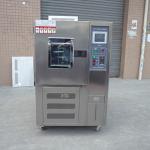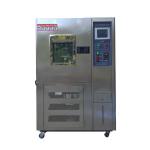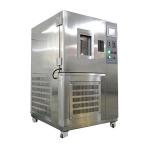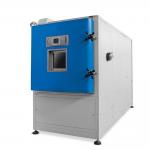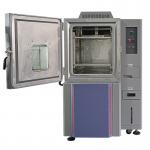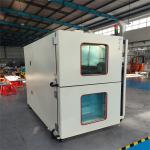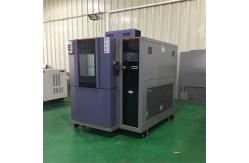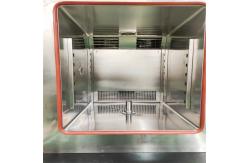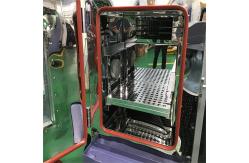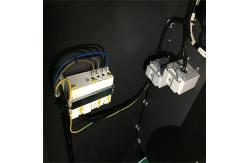In the field of product reliability testing, the need for efficient
and accurate evaluation of a product's performance under extreme
temperature conditions has led to the development of advanced
testing equipment. The customized ESS Rapid Temperature Experiment
Chamber Automatic is a state-of-the-art solution that offers
enhanced capabilities and automation features for comprehensive
environmental stress screening. This highly specialized chamber is designed to subject products to
rapid and extreme temperature changes in an automated manner. It
serves a wide range of industries, including aerospace, automotive,
electronics, and telecommunications. The primary objective is to
identify potential weaknesses and defects in products by simulating
the harsh temperature conditions they may encounter during their
lifecycle. By conducting Environmental Stress Screening (ESS)
tests, manufacturers can improve product quality, reduce field
failures, and enhance customer satisfaction. - Robust and Insulated Chamber Structure
- The chamber is constructed with a heavy-duty steel frame that
provides exceptional rigidity and stability. The frame is coated
with a corrosion-resistant finish to ensure long-term durability.
The chamber walls are made of high-quality insulation materials,
which minimize heat transfer and maintain precise temperature
levels. The insulation is carefully engineered to withstand the
rigors of continuous testing and prevent any external factors from
interfering with the internal test environment. The chamber is also
equipped with a hermetic door seal, ensuring a leak-free enclosure
and consistent test conditions.
- High-Speed Temperature Control System
- The chamber features a rapid temperature control system that can
achieve extremely fast temperature change rates. It can transition
from a low temperature of -70°C to a high temperature of +180°C in
a remarkably short time, with a maximum rate of change of up to
30°C per minute. The system utilizes advanced refrigeration units,
electric heaters, and a sophisticated control algorithm to ensure
accurate and repeatable temperature profiles. Temperature sensors
are strategically placed within the chamber to provide real-time
feedback, enabling the control system to make rapid and precise
adjustments.
- Automated Test Sequence Programming
- The ESS Rapid Temperature Experiment Chamber Automatic comes with a
user-friendly software interface that allows for easy programming
of complex test sequences. Operators can define the temperature
profiles, dwell times, and cycle repetitions according to specific
test requirements. The software also enables the creation of
conditional tests, where the chamber's operation can be adjusted
based on the product's response or other external factors. This
automation feature not only saves time but also ensures the
consistency and reproducibility of test results.
- Data Logging and Analysis Capabilities
- The chamber is equipped with a comprehensive data logging system
that records all relevant test data, including temperature
profiles, temperature change rates, and any alarms or events that
occur during the test. The logged data can be stored in a built-in
memory or exported to external storage devices for further
analysis. The software also provides tools for generating detailed
test reports, including graphs and statistical analysis of the
data. This allows engineers and quality control personnel to easily
assess the performance of the product under test and make informed
decisions about product design and manufacturing processes.
- Safety and Protection Mechanisms
- To ensure the safety of operators and the integrity of the testing
process, the chamber is equipped with a range of safety features.
It has emergency stop buttons strategically located for immediate
shutdown in case of any abnormal situation. The chamber is also
protected against over-temperature and over-current conditions,
with built-in safety circuits that automatically cut off power if
necessary. Additionally, the chamber is designed to prevent any
refrigerant leaks, and it has a ventilation system to ensure the
removal of any potentially harmful gases.
- Maximum Temperature Swing Rate
- As mentioned, the chamber can achieve a maximum temperature swing
rate of 30°C per minute. This rapid rate of change is essential for
simulating the sudden temperature fluctuations that products may
experience in real-world applications. For example, in aerospace
electronics, components may be exposed to rapid temperature changes
during flight, and this chamber can accurately replicate those
conditions to evaluate the component's reliability.
- Temperature Control Range
- The chamber can maintain a wide temperature control range, from
-70°C to +180°C. This broad range allows for the testing of
products that may be used in extreme cold or hot environments. For
instance, in the automotive industry, engine components need to
withstand high temperatures, while electronic control units may
need to function properly in cold start conditions.
- Testing Volume and Payload Capacity
- The chamber offers a customizable testing volume, with options
ranging from 1 m³ to 20 m³. The payload capacity can be adjusted
according to the size and weight of the test samples, with a
maximum capacity of up to 2000 kg. This flexibility allows for the
testing of a wide variety of products, from small electronic
devices to large industrial machinery components.
- Temperature Uniformity
- The chamber ensures excellent temperature uniformity throughout the
testing space. The temperature variation within the chamber is
typically within ±1°C, ensuring that all parts of the test sample
are exposed to the same temperature conditions. This is crucial for
obtaining accurate and reliable test results, especially when
testing large or complex products.
- Dwell Time Accuracy
- The chamber can maintain the specified dwell times at different
temperature levels with an accuracy of ±1 minute. Dwell time is an
important parameter in ESS testing, as it determines the length of
time the product is exposed to a particular temperature. Accurate
control of dwell time ensures that the test is conducted in
accordance with the defined test plan and provides consistent
results.
- Efficient Environmental Stress Screening
- The primary function of the chamber is to perform rapid and
automated Environmental Stress Screening. By subjecting products to
extreme temperature changes and carefully controlled test
sequences, it helps to identify latent defects and weaknesses in
the product design or manufacturing process. This allows
manufacturers to take corrective actions early in the production
cycle, reducing the cost of quality and improving overall product
reliability.
- Product Design Optimization and Validation
- Through a series of tests on different product prototypes, the data
obtained from the chamber can be used to optimize product designs.
Engineers can analyze the behavior of various components and
materials under different temperature stress levels and make design
modifications to enhance the product's performance and durability.
The chamber also serves as a valuable tool for validating the final
product design, ensuring that it meets the required reliability
standards.
- Quality Control and Reliability Assurance
- The chamber is an essential part of the quality control process. It
allows manufacturers to perform routine tests on production batches
to ensure that each unit meets the specified quality and
reliability criteria. By detecting and eliminating defective
products before they reach the market, companies can avoid costly
recalls and maintain their reputation for quality.
- Research and Development Support
- In the field of research and development, the chamber offers
valuable insights into the behavior of materials and products under
extreme temperature conditions. Researchers can use it to study the
fundamental properties of new materials, explore the effects of
temperature on product performance, and develop innovative
solutions to improve product reliability. For example, in the
electronics industry, it can be used to investigate the thermal
stability of new semiconductor materials or the performance of
electronic circuits under temperature stress.
- Stringent Manufacturing Process
- The customized ESS Rapid Temperature Experiment Chamber Automatic
is manufactured under strict quality control procedures. Each
component, from the steel frame and insulation materials to the
temperature control system and software, is sourced from reliable
suppliers and undergoes thorough inspection and testing. The
assembly process is carried out by highly trained technicians in a
clean and controlled environment. The chamber is calibrated and
verified at multiple stages during production to ensure its
accuracy and performance.
- Quality Certification and Validation
Our chamber has obtained relevant quality certifications and has
been validated by independent testing laboratories. It has been
proven to provide accurate and reliable test results, conforming to
international and national standards for environmental stress
screening and temperature testing. We also continuously update and
improve our product based on the latest technological advancements
and customer feedback to ensure its long-term performance and
compliance.
|
